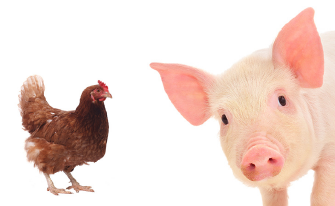This problem solving activity has a number focus.
One third of the animals in the barn are chickens. The rest are pigs.
There are 20 legs in all.
How many pigs are there?
- Find fractions of whole numbers.
- Devise and use problem-solving strategies (draw a picture, guess and check).
The focus of this problem is on fractional parts of a set. The problem encourages students to approach fraction operations through number sense and logical thinking rather than through the memorisation of rules. Other contexts for this problem could include bicycles, tricycles and a number of wheels, or spiders and bugs, and a number of legs.
- Copymaster of the problem (Māori)
- Copymaster of the problem (English)
- Animal models or pictures
The Problem
One third of the animals in the barn are chickens. The rest are pigs. There are 20 legs in all. How many pigs are there?
Teaching Sequence
- Use the animal models or pictures to introduce the problem to the class.
- Brainstorm possible approaches to solving the problem (e.g. draw, guess). Encourage the students to plan ways of recording their work so that others will be able to understand what they have done.
- As the students solve the problem, ask questions that focus them on their thinking about fractions.
How do you work out a third?
What is the total number of legs? Will this number be the numerator or denominator of a fraction?
How many thirds make up 1 whole?
How many legs make up our '1 whole'? - Share solutions and records.
Extension
Write your own barn fraction problem which has 6 as the answer.
Solution
4 pigs
One way to do this problem is to use a table. Before we start though, notice that: (1) if one third of the animals are chickens, then two thirds are pigs, and (2) since there are a whole number of chickens, there must be three times a whole number of animals.
| animals | chickens | pigs | legs |
| 3 | 1 | 2 | 10 |
| 6 | 2 | 4 | 20 |
Noticing part (2) makes it possible to get the answer very quickly.
